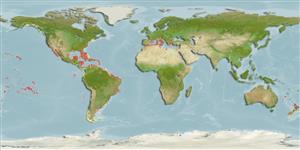Common names from other countries
Environment: milieu / climate zone / depth range / distribution range
Ecología
Bentopelágico; rango de profundidad 0 - 20 m (Ref. 116114). Subtropical
Distribución
Países | Áreas FAO | Ecosistemas | Ocurrencias, apariciones | Introducciones
Eastern Central Pacific, Western Central Atlantic and the Mediterranean.
Length at first maturity / Tamaño / Peso / Age
Maturity: Lm ? range ? - ? cm Max length : 4.0 cm H macho / no sexado; (Ref. 2376)
Stings are painful; second most important stinging jellyfish on the southcoast of Italy; in the coast of Denia (Western Mediterranean Sea), summer of 2008, it showed an unusual high density and stung as many as 185 people d-1 (Ref. 116819). Neritic (Ref. 116114). Inhabits near shore, mangrove channels, and kelp forests (Ref. 1028). Polyps were once located attached to bivalve shells in a mangrove habitat in Puerto Rico, suggesting estuarine polyps (Ref. 116835). Medusae are associated with sandy beach with Posidonia oceanica meadows (Ref. 116819). Pathogenic (Ref. 116114). Mainly feeds on copepods, mysids and gammarids (Ref. 116521). Temperature is the main factor which affects its spatio-temporal abundance along the SW Mediterranean; other variables were low salinity and high coastal productivity (chl a and phosphate) (Ref. 116819).
Cairns, S.D., D.R. Calder, A. Brinckmann-Voss, C.B. Castro, D.G. Fautin, P.R. Pugh, C.E. Mills, W.C. Jaap, M.N. Arai, S.H.D. Haddock and D.M. Opresko. 2003. (Ref. 1663)
IUCN Red List Status (Ref. 130435)
CITES status (Ref. 108899)
Not Evaluated
Not Evaluated
Threat to humans
Harmless
Human uses
| FishSource |
Herramientas
Más información
Age/Size
Crecimiento
Length-weight
Length-length
Morfología
Larva
Abundancia
Fuentes de Internet
Estimates based on models
Vulnerability
Low vulnerability (10 of 100).
Price category
Unknown.
